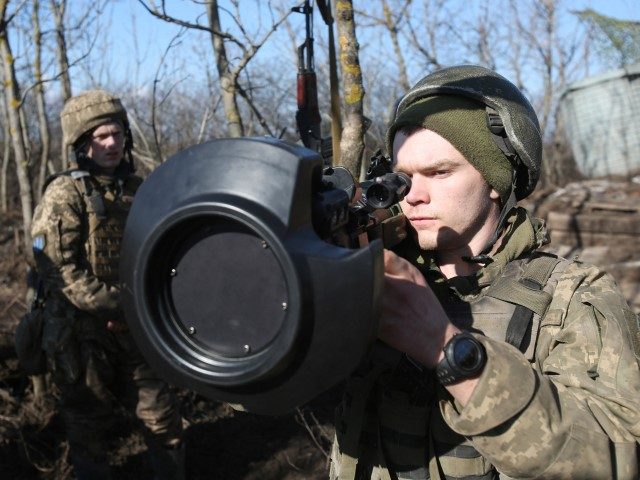Ukrainian forces are reporting success in using American-made Javelin anti-tank missiles against invading Russian armor. British NLAW weapons are also reportedly performing well against Russian tanks.
The FGM-148 Javelin Close Combat Missile System-Medium (CCMS-M) is an advanced man-portable anti-armor weapon developed in a joint venture by Raytheon and Lockheed-Martin to replace the M47 Dragon in the mid-1990s. It is possible to mount Javelins on robot vehicles and fire them remotely. Javelins are employed by the U.S. Army and Marines to counter enemy armor, penetrate hard targets like bunkers, and even destroy helicopters.
The Javelin’s advantages include “soft launch” capability with minimal exhaust fumes and recoil, making it possible to launch them from inside buildings during urban combat operations; a top-attack flight profile that sends the missile above its target, giving it a chance to find the weakest point in enemy armor before it strikes; fire-and-forget electronics that allow the users to move quickly out of harm’s way after firing; and double warheads that have proven very effective at defeating all existing forms of armor.
Javelins are noted for their high degree of reliability and effectiveness in adverse battlefield conditions, the remarkable accuracy of their targeting computers, and excellent range for such a light weapon. The entire Javelin launch and targeting package weighs less than 50 pounds. It takes about 30 seconds to set up and fire, and perhaps 20 seconds to reload.
Military analysts regard the Javelin as the premier anti-tank weapon in the world, with only a few other platforms coming close to its battle-tested capabilities. Perhaps the highest tribute to its quality is that the Chinese stole it as quickly as possible.
The Dragon missile superseded by the Javelin had plenty of armor-piercing power, but it was bulkier, less reliable, had shorter range, and lacked ability to fly above armored vehicles and strike down at their weak points. The final nail in the Dragon’s coffin was the introduction of “reactive armor” on late-model Soviet tanks, a form of armor that sacrifices an outer layer of disposable tiles to blunt the impact of anti-tank missiles. Javelins defeat reactive armor by using their first warhead to disperse the reactive tiles, then punching through the enemy’s main armor layer with the second warhead.
Ukraine received a shipment of Javelins as recently as late January, as part of the latest $200 million security package offered by the United States. On Friday, Estonia announced it would send some of its Javelin inventory to Ukraine, along with food, medical equipment, and protective gear.
At around the same time, the British government hurriedly shipped almost 200 units of its RB-57 Next Generation Light Antitank Weapon (NLAW) to Ukraine, adding to almost 2,000 previously delivered. The U.K. also sent paratroopers to train the Ukrainians in effective use of the NLAW.
The NLAW is a British-Swedish collaboration that has some similarities to the Javelin, including components provided by Raytheon. The platform was developed in the early 2000s and saw action on the battlefields of Yemen, having been purchased by Saudi Arabia.
Like the Javelin, NLAWs have soft-launch features, top-attack mode, and fire-and-forget targeting. The NLAW has considerably shorter range than the Javelin, but has the advantage of much lower production costs. Some analysts believe the NLAW will become the more popular of the two platforms in the future as drones take over the longer-range targeting functions of the Javelin.
The Ukrainian military claimed on Thursday to have wiped out an entire column of fifteen Russian T-72 tanks using Javelins. The American-made weapons appear to be a good fit for engagements in the open plains and long roads of eastern Ukraine.
#Ukraine 🇺: reports that a Russian military convoy was ambushed close to Hlukhiv in the #Sumy region. ukrainian soldiers targeted the vehicles with javelin missiles, inflicting some heavy damage. pic.twitter.com/3HfPSwDmIj
— Thomas van Linge (@ThomasVLinge) February 24, 2022
Former Ukrainian President Petro Poroshenko, during an interview on Friday in which he brandished a rifle and announced he would join the troops defending Kyiv, made a point of thanking America and the United Kingdom for providing Ukraine’s defenders with Javelins. (He might have been thinking of the NLAW when praising the U.K. contribution).
“I want to inform you my battalion has Javelin. And every single shot will be Russian tank was successful and effective. This is also your part of success. Thank you,” Poroshenko said.
The UK Telegraph on Friday reported Ukrainian forces are using NLAWs as well as Javelins to great effect against Russian armor. Russian state media reported on Friday that one of Ukraine’s NLAWs was captured on the battlefield by invading forces:
Russia’s NTV says a British NLAW provided to Ukraine has been captured. https://t.co/bTXlOMDylP pic.twitter.com/uacp8Z1u4L
— Rob Lee (@RALee85) February 25, 2022
U.K. Armed Forces Minister James Heappey said on Friday the missiles have “already proved invaluable” to the defenders.
Heappey said the U.K. is “aware of the number of circumstances” in which NLAWs “have been used to defeat Russian armor.” He said this was a significant factor in the Russian invasion proceeding more slowly than its planners expected.
“Suffice it to say that we are fairly certain that in the Kremlin last night there will have been some rather urgent reflections on the speed of progress compared to what they were anticipating,” Heappey said.
“I think the Russian people should call out President Putin and the kleptocracy around him about this, because young Russian men and women are being sacrificed in the name of President Putin’s hubris,” he suggested.

COMMENTS
Please let us know if you're having issues with commenting.